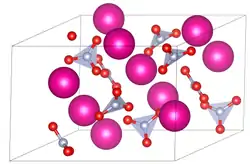Rubidium nitrate
Rubidium nitrate is an inorganic compound with the formula RbNO3. This alkali metal nitrate salt is white and highly soluble in water.
 | |
 Unit cell of rubidium nitrate | |
| Names | |
|---|---|
| IUPAC name
Rubidium nitrate | |
| Identifiers | |
3D model (JSmol) |
|
| ChemSpider | |
| ECHA InfoCard | 100.032.767 |
| EC Number |
|
PubChem CID |
|
| RTECS number |
|
CompTox Dashboard (EPA) |
|
| |
| |
| Properties | |
| RbNO3 | |
| Molar mass | 147.473 g/mol |
| Appearance | White hygroscopic solid |
| Density | 3.11 g/cm3 |
| Melting point | 310 °C (590 °F; 583 K) decomposes |
| Boiling point | 578 °C (1,072 °F; 851 K) |
| 44.28 g/100 mL (16 °C), 65 g/100 mL (25 C)[1] | |
| −41.0·10−6 cm3/mol | |
Refractive index (nD) |
1.524 |
| Structure[2] | |
| trigonal | |
| P31 | |
a = 10.474 Å, c = 7.443 Å | |
Lattice volume (V) |
707.2 Å3 |
| Hazards | |
| Main hazards | Oxidant |
| NFPA 704 (fire diamond) | |
| Flash point | Non-flammable |
| Lethal dose or concentration (LD, LC): | |
LD50 (median dose) |
4625 mg/kg (rat, oral) |
| Related compounds | |
Other anions |
Rubidium sulfate Rubidium chloride |
Other cations |
Lithium nitrate Sodium nitrate Potassium nitrate Caesium nitrate |
Except where otherwise noted, data are given for materials in their standard state (at 25 °C [77 °F], 100 kPa). | |
| Infobox references | |
Properties

Rubidium nitrate is a white crystalline powder that is highly soluble in water and very slightly soluble in acetone. In a flame test, RbNO3 gives a mauve/light purple colour.
Uses
Rubidium compounds have very few applications.[1] Like caesium nitrate, it is used in infrared radiation producing pyrotechnic compositions as a colorant and an oxidizer, e.g. in decoys and illumination flares. It is also used as a raw material for preparation of other rubidium compounds and rubidium metal, for manufacture of catalysts and in scintillation counters. It is rarely used in fireworks to produce a red-violet colour.
Production
RbNO3 can be prepared either by dissolving rubidium metal, its hydroxide or carbonate in nitric acid.
- RbOH + HNO3 → RbNO3 + H2O
- 2 Rb + 2 HNO3 → 2 RbNO3 + H2
References
- W. Lenk, H. Prinz, A. Steinmetz,"Rubidium and Rubidium Compounds" in Ullmann's Encyclopedia of Industrial Chemistry, 2010 Wiley-VCH Verlag GmbH & Co. KGaA, Weinheim. doi:10.1002/14356007.a23_473.pub2
- Jutta Pohl, Dieter Pohl, Gunadi Adiwidjaja (1992). "Phase Transition in Rubidium Nitrate at 346 K and Structure at 296, 372, 413 and 437 K". Acta Crystallographica Section B. B48: 160–166. doi:10.1107/S0108768191013459.CS1 maint: multiple names: authors list (link)
| HNO3 | He | ||||||||||||||||
| LiNO3 | Be(NO3)2 | B(NO 3)− 4 |
RONO2 | NO− 3 NH4NO3 |
HOONO2 | FNO3 | Ne | ||||||||||
| NaNO3 | Mg(NO3)2 | Al(NO3)3 | Si | P | S | ClONO2 | Ar | ||||||||||
| KNO3 | Ca(NO3)2 | Sc(NO3)3 | Ti(NO3)4 | VO(NO3)3 | Cr(NO3)3 | Mn(NO3)2 | Fe(NO3)2 Fe(NO3)3 |
Co(NO3)2 Co(NO3)3 |
Ni(NO3)2 | CuNO3 Cu(NO3)2 |
Zn(NO3)2 | Ga(NO3)3 | Ge | As | Se | Br | Kr |
| RbNO3 | Sr(NO3)2 | Y(NO3)3 | Zr(NO3)4 | Nb | Mo | Tc | Ru(NO3)3 | Rh(NO3)3 | Pd(NO3)2 Pd(NO3)4 |
AgNO3 Ag(NO3)2 |
Cd(NO3)2 | In(NO3)3 | Sn | Sb(NO3)3 | Te | INO3 | Xe(NO3)2 |
| CsNO3 | Ba(NO3)2 | Hf(NO3)4 | Ta | W | Re | Os | Ir | Pt(NO3)2 Pt(NO3)4 |
Au(NO3)3 | Hg2(NO3)2 Hg(NO3)2 |
TlNO3 Tl(NO3)3 |
Pb(NO3)2 | Bi(NO3)3 BiO(NO3) |
Po(NO3)4 | At | Rn | |
| FrNO3 | Ra(NO3)2 | Rf | Db | Sg | Bh | Hs | Mt | Ds | Rg | Cn | Nh | Fl | Mc | Lv | Ts | Og | |
| ↓ | |||||||||||||||||
| La(NO3)3 | Ce(NO3)3 Ce(NO3)4 |
Pr(NO3)3 | Nd(NO3)3 | Pm(NO3)3 | Sm(NO3)3 | Eu(NO3)3 | Gd(NO3)3 | Tb(NO3)3 | Dy(NO3)3 | Ho(NO3)3 | Er(NO3)3 | Tm(NO3)3 | Yb(NO3)3 | Lu(NO3)3 | |||
| Ac(NO3)3 | Th(NO3)4 | PaO2(NO3)3 | UO2(NO3)2 | Np(NO3)4 | Pu(NO3)4 | Am(NO3)3 | Cm(NO3)3 | Bk | Cf | Es | Fm | Md | No | Lr | |||

